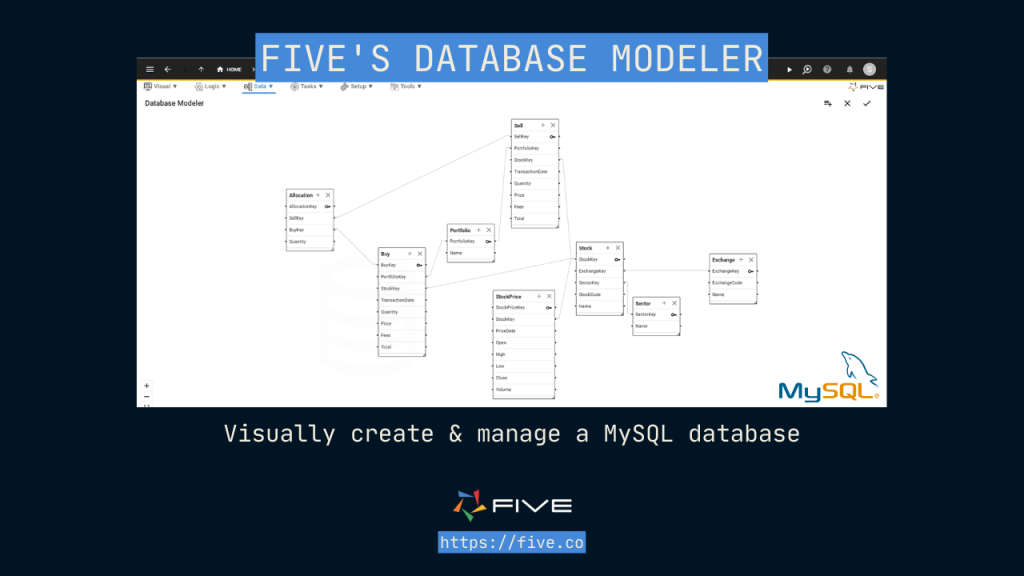How to Create a Database for Small Business
Learn How to Create a Database for Your Business
Setting up a database for a small business might sound daunting, but with the right tools, it becomes a straightforward task. There are many options available. Today’s modern database builders make SQL simple and offer fast and easy ways to develop a database and build a user interface. They are cost-effective too: Five, for example, offers its Basic plan at just US$29.99 per app/month.
Let’s learn how modern database tools offer a balance of user-friendliness and versatility, simplifying the process of database creation for businesses and companies of all sizes. But before diving into the specifics, let’s unpack why an effective database is such a game-changer for small businesses and how you can create yours today.
Why Does Your Business Need a Customised Database?
Let’s break down why having a tailored database for small businesses is a necessity.
- Data Accessibility
Ever been on the go and needed that one piece of information, but couldn’t access it? It’s frustrating, isn’t it? That’s why it’s essential for data to be accessible across various devices, ensuring information is always at your fingertips. - Flexibility and Scalability
Every business is unique, with its own set of challenges and needs. Off-the-shelf solutions might seem tempting, but they can be like trying to fit a square peg into a round hole. A customized database for your small business offers the flexibility to grow with your business, ensuring that as your operations expand, your database keeps pace. - Integration with Existing Processes
Many businesses, especially when starting out, rely heavily on tools like Excel. But as you scale, these processes can become cumbersome. Transitioning to a database application, especially when you create a database for small businesses ensures that these operations evolve into more robust, scalable solutions.
As you start out, Excel might suffice for your data needs. However, Excel is not a substitute for a proper database. As your business expands, a customized database becomes essential not just for storage but also for effective data visualization.
Key Steps in Setting Up a Database for Small Business
Databases are the unsung heroes for small businesses. A recent article by EY highlights that an overwhelming 53% of senior executives are now earmarking data and analytics as their top investment priority. Given such data-centric inclinations, it’s imperative for small businesses to understand the steps involved in setting up a robust database.
Here are the steps involved in creating a database for your company:
- Defining the Business Requirement
What’s the primary function you want your database to serve? Is it for inventory management, customer relationship tracking, or sales analytics? A clear definition at this stage sets the course for the subsequent steps. - Choosing the Right Platform
The market today is full of database platforms, each with its unique offerings. While making a choice, it’s essential to strike a balance between comprehensive functionalities, cost, and user-friendliness. Platforms like Five are gaining traction as the preferred choice for creating a database for small businesses, but the final choice should resonate with your specific business needs. - Database Design
Here, the technical groundwork is laid. From setting up coherent tables to defining table relationships between them, this step is crucial for the database’s long-term efficiency and reliability. Make sure to get your many-to-many or one-to-many relationships right when creating your database design. Fixing database errors later in the process can cost a lot of time. - Data Import and Integration
Once the entity-relationship diagram or database scheme is in place, the next task is populating the database. Popular methods like CSV imports are commonly used, but it’s crucial to ensure the integrity and relevance of the data being transferred. Make sure your primary keys and foreign key relationships are properly defined to avoid data redundancy and duplication. - Implementing Business Logic
A database is more than a storage unit. It should be an active participant in business operations. Designing custom queries and reports can help businesses derive actionable insights from their data, facilitating informed decision-making.
What Is The Best Database Software For Small Businesses
Finding the right database software for your company often involves a long and tedious search, comparing features, pricing, and case studies. In the past, the answer was often simple: tools such as Microsoft Access or FileMaker dominated the small business database market. But since the emergence of the web, this has changed. More modern technologies have captured the market.
Here’s a shortcut to finding the right database solution for your business:
First, what’s your monthly budget? Some tools, such as Five, offer very competitive entry-level plans. For example, Five’s Basic plan costs just US$29.99 per app and month including unlimited end-users. Other database builders rapidly get more expensive when more users access the database.
Second, what is the underlying database? Our recommendation: pick a database builder that uses a relational database, such as MySQL or PostgreSQL as their underlying database. Why? It’s incredibly easy to find support for SQL and you are minimizing lock-in. SQL databases can be deployed anywhere. With SQL, your data stays portable.
Third, watch one tutorial for the tools you are considering. Based on the tutorial, determine if you are comfortable with the tools’ methodology for building a small business database. Tools such as Five include many visual database creation features, such as a visual database modeler, or a point-and-click table builder.
Creating a Robust Database with Five
Oftentimes, small businesses want to create a database to convert spreadsheets into web applications. To non-programmers, this might sound daunting, but with tools like Five, the process is not only streamlined but also user-friendly. Let’s delve into how you can set up a comprehensive database with Five:
1. Spreadsheet Preparation:
- Structured Headers: Your first row in Excel should clearly define the content of each column. For instance:
Product | Price | Quantity. - Consistent Data Formatting: Ensure consistent data types across rows for individual columns, be it text, numbers, or other formats.
- Data Cleaning: Utilize Excel functions like
TRIM,CLEAN, andPROPERto standardize and clean your data.
2. Setting Up Your Database in Five:
- Initiating a New Application: After installing and launching Five, navigate to create a new application.
- Database Creation & Data Import:
- Within Five, proceed to
Data > Tablesto initiate a new database table. - Label your table appropriately and define the fields that match your spreadsheet’s columns.
- Use Five’s “Import CSV into Table” function to seamlessly upload your data.
- Within Five, proceed to
3. Enhancing User Interaction with Forms:
- Form Development: Forms provide the interactive interface of your application. In Five, you can create a form, choosing your primary table, like “Inventory”, as a reference.
- Preview and Refine: Before deploying, always preview your application. This allows you to experience the user’s perspective and make any necessary tweaks.
4. Advanced Features and Customizations:
- Theming: Personalize your application’s appearance using Five’s theming options to align with your brand or desired aesthetics.
- Data Visualization: Integrate charts or dashboards to derive insights from your data visually.
- Advanced Data Views: Exhibit your data in varied formats, including editable grids, for enhanced user experience.
- Data Integrity: Implement data validation rules to ensure consistent and accurate data entry.
- User Management: Create a layered access system with logins, varied user roles, and permissions. This ensures data security and tailored user access.
By leveraging Five, you can create a database for your small business that’s not just for storage; but also a tool that can help your business to make informed decisions through accessible data. Because the essence of a good database isn’t just storage; it’s about facilitating better business decisions through data.

Benefits of Converting Spreadsheets into Web Applications with Five
Transitioning from traditional spreadsheets to a web application through platforms like Five brings many advantages. Here’s a comprehensive look at the benefits:
- Enhanced Data Integrity:
- Web applications reduce the risk of human errors that commonly occur in spreadsheets, such as accidental deletions or incorrect data entries.
- Five’s database environment ensures that each data point adheres to its intended format, ensuring data accuracy.
- Scalability:
- As your business grows, so will your data. Traditional spreadsheets can become sluggish or even crash with large datasets. Web applications, on the other hand, are built to handle vast amounts of data without compromising on performance.
- Real-time Collaboration:
- Multiple users can access, edit, and update the web application simultaneously. This is quite a contrast to spreadsheets where sharing and real-time collaboration can be clunky.
- Enhanced Security:
- One of the key reasons to create a database for small business is security. Web applications allow for more refined user access controls. With Five, you can assign specific roles, permissions, and access levels, ensuring that sensitive data is only accessible to authorized personnel.
- Automation and Efficiency:
- Automate repetitive tasks, generate reports with a click, and set up alerts or triggers. This kind of automation is often cumbersome or impossible in traditional spreadsheets.
- Greater Accessibility:
- Web applications are accessible from anywhere with an internet connection. Whether you’re in the office, at home, or on the move, your data is at your fingertips.
- Tailored User Experience:
- Customize the interface, workflows, and functionalities to match your business processes precisely. This level of customization goes beyond the capabilities of standard spreadsheet software.
- Data Visualization and Reporting:
- Integrated tools in Five allow for the creation of dashboards, charts, and visual reports, helping businesses derive insights and make informed decisions.
- Cost-Efficient in the Long Run:
- While there’s an initial investment in setting up a web application, the long-term benefits of reduced errors, increased efficiency, and saved man-hours make it a cost-effective choice.
Conclusion
Databases, with their powerful capabilities, often form the backbone of complex applications that drive businesses forward. They open up a world of business analytics, business intelligence, streamlined processes, and data-informed decision-making. One mustn’t see them as mere repositories for storing information; their potential reaches far beyond. They are the backbone of modern data management.
For instance, Project Management Tools, which are integral to many organizations, rely heavily on databases. They store tasks, track progress, and facilitate collaboration.
As Stephanie Nashawaty from SAP points out, “Historically, C-suite leaders found themselves hamstrung by their disparate technology stacks and siloed decision-making capabilities.” Modern Project Management Tools, underpinned by robust databases, address such siloes and empower teams to work seamlessly.
Similarly, Content Management Systems (CMS) have databases at their core. They store articles, images, and other content types, allowing businesses to easily manage and distribute information across digital platforms.
Moreover, the transition from static data to real-time data analytics can enhance applications like Customer Relationship Management (CRM) tools, which now offer real-time insights into customer behavior, preferences, and feedback.
Platforms like Five are at the forefront of this. Not only do they provide the foundation for creating tailored databases, but they also offer a variety of templates and functionalities. This allows businesses to develop bespoke applications, from inventory management systems to advanced analytic tools, all built upon a solid database foundation.
Free Tutorial: Build an Online Database App
Learn how to build an entire web app by following our step-by-step app development guide.
The guide starts by creating a new, custom database from scratch and finishes with a web app that contains a chart, PDF reports, and forms for users to interact with your data. You will learn how to combine all these front-end elements with your back-end database.
Best of all: it’s free to follow!


